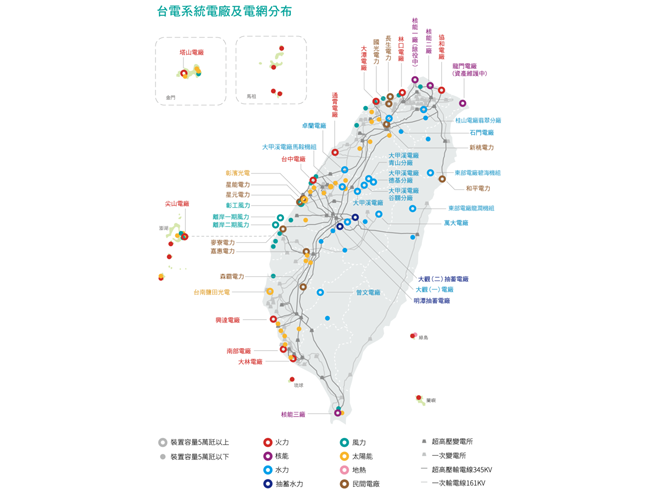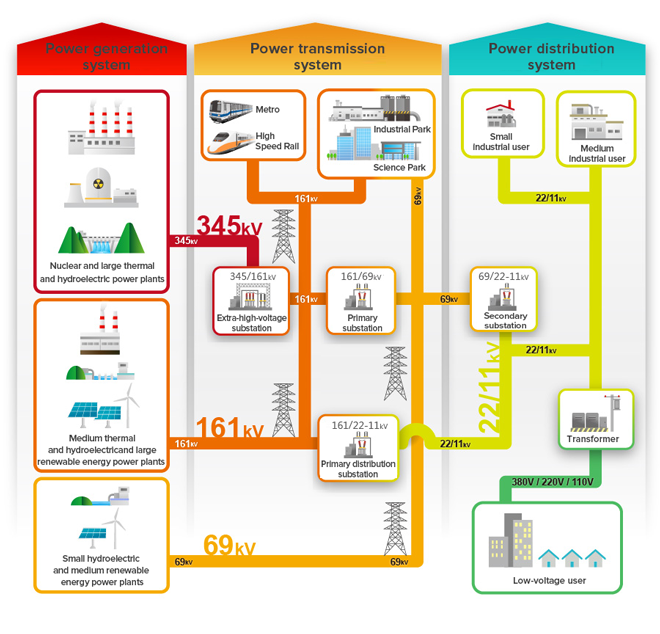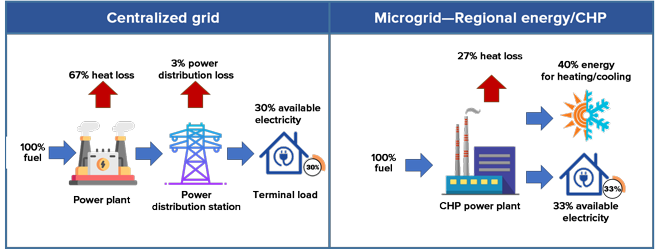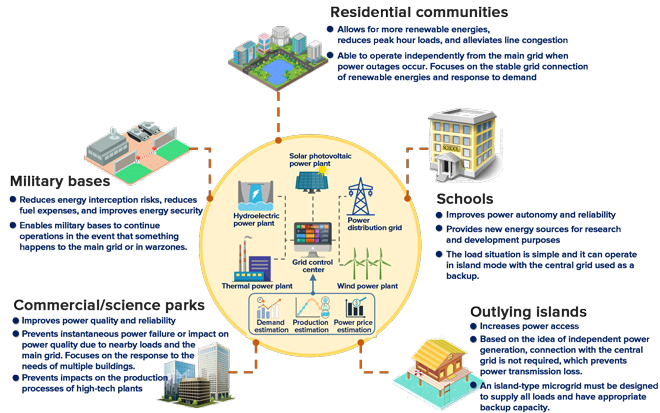Technology
技術分享
Deployment and Advantages of Smart Microgrids
— Peng-Hui Chen, Senior Engineer at CTCI SEC, Group Intelligent Solutions Business
With the greenhouse effect and climate change becoming global issues, and demand for electricity continues to increase, the future power source must have characteristics of high reliability, high quality, high efficiency, and low carbon emission. The rapid development of smart technologies also propels countries worldwide to actively invest in the deployment of smart grids. A smart grid digitizes and visualizes the supply and usage of a power grid through information, communication, and automation technologies. Power information is integrated and analyzed to achieve the optimal configuration of power resources. In order to ensure the safety and reliability of electrical grid supply, more intelligent, real-time adjustments, and more precise loads prediction and control must be made available. Owning to the reason, it has become an international trend to develop smart power grids. In response to Taiwan’s Pathway to Net-Zero Emissions in 2050 and General Strategy Description, Taiwan’s smart power grid has adopted the deployment strategies of developing diverse energies and integrating distributed power grids. This article will discuss topics from distributed power to energy transformations and the establishment of smart micro grids. Hopefully, it can be used as reference for subsequent engineering designs.
Distributed Power Supply Achieves System Stability by Allocating Power Generation
Countries around the world have made progress to reduce usage of fossil fuels and nuclear energy while expanding development in renewable energies. With frequent power outages due to natural disasters, centralized power grids are being put to the test. A distributed grid structure has become the trend for current power systems. Compared to centralized power grids, micro grids can reduce transmission and distribution losses, lower the threshold for construction, improve regional power supply stability, and regulate peak power usage promptly. The early stages of Taiwan’s power development (before 1953) were mainly based on hydroelectric power. The focus then moved towards thermal power generation and nuclear power. Currently, Taiwan’s power system is a distributed power grid with diverse energy sources. However, thermal power generation still accounts for the largest percentage of total generation. Driven by international carbon reduction energy policies, Taiwan is also promoting new energy solutions.

Distribution map of Taiwan’s power plants and grids (source: Taiwan Power Company)
Taiwan’s current development of new energy solutions mainly focuses on solar and wind power; evaluation of geothermal, ocean, and other forward-thinking technologies; imported carbon-neutral natural gas; and the addition of hydrogen in gas combustion for power generation. We are gradually implementing net-zero transformations for the energy systems and creating a zero-carbon power system. For TPC power grid, a major direction is to establish distributed grid to realize energy transformations.
Energy Transformation: Building a Zero-carbon Power System, Improving Energy System Resilience & Creating Green Growth
Taking a look at the present TPC power supply system, we see that power is generated by medium and large nuclear, hydroelectric, and thermal power plants with pressure raised to extra-high voltage at 345 kV (kilovolts) using transformers. The transmission lines are used to transport electricity to extra-high voltage substations and primary substations to lower the voltage to 161 kV and 69 kV. Power generated is then provided to energy-heavy users, such as science parks, industrial parks, the high speed rail, and metro networks. The power voltage is further lowered by distribution substations, secondary substations, and the distribution system before being provided to general users or households. When capabilities of power supply or transmission for power plant, transmission lines, or substations become inadequate, supply of power will be impacted.

Introduction of TPC’s power supply system (source: Taiwan Power Company)
Taiwan’s energy transformation plan is centered on building a zero-carbon power system, improving energy system resilience, and creating green growth as goals and directions. I. Create a zero-carbon power system
Currently, Taiwan’s electricity is largely dependent on thermal power generation. The disadvantage of thermal power generation is that it creates large amounts of carbon emissions and air pollution. Therefore, energy system will be transformed from the centralized power generation of traditional grids to distributed, hybrid grids. Specific development directions include expanding the deployment of mature renewable energies (solar and wind power) along with forward-thinking geothermal and ocean power. Natural gas and hydrogen-ammonia mixing technology will be introduced to reduce carbon emissions of thermal power generation. Industrial transportation will adopt hydrogen-ammonia and biomass fuel for energy to propel Taiwan’s energy system towards zero-carbon target.
II. Improving energy system resilience
Taiwan’s existing power grid structure is insufficiently resilient, which leads to the need for manual repairs due to a variety of factors. To improve the resilience, the capacity of renewable energy grids is being expanded and the adaptability and system integration of the grid are being strengthened. In the future, grid resilience will be further improved through the promotion of grid digitization and the integration of ICT and IoT technologies, such as energy storage resources and micro grid power generation integration.
III. Creating green growth
In recent years, various countries have invested substantial resources into the development of key technologies for decarbonizing energy, and the results will affect national competitiveness. Taiwan is also integrating resource budgets to invest in technology research and development having solid strengths, fostering domestic components to create a green energy industry ecosystem, and promoting technological cooperation by establishing international partnerships. In the future, state-owned enterprises will also take the lead in investing in the net-zero transformation of the energy system. The government as well will provide incentives, subsidies, and tax concessions, while major enterprises will invest in the development and application in relation to energy transformation.
Smart Microgrids: Providing Support to the Power Grid in Emergencies and Lowering Costs
Aside from the directions of development mentioned above, the concept of microgrid application has become an important part of distributed power grids. Microgrids are controllable local energy systems which can be disconnected from the traditional grid and operate autonomously. Whether connected to the central grid or operating independently, they can range in scale from small power companies to residential buildings. These grids can operate independently and even have spare power to provide electricity instead when supply from the central grid is insufficient, and are characterized by low construction thresholds and high power generation efficiency. Advanced countries around the world have made development strategies and plans for micro grids. In summary, compared to centralized grids, micro grid (regional energy) has the following advantages:
I. High overall efficiency
Microgrids are used for local power generation, which can reduce power transmission and distribution losses. The overall efficiency of centralized power grids is 30% to 40%, whereas that of micro grids can reach up to 80% to 90%.
II. Low construction threshold
Microgrids do not necessitate national and policy planning, making it is easier to find installation locations. They also require shorter construction time, and relatively lower construction costs.
III. Improving regional grid supply stability and reliability
In the event of power outage or power failure in the power grid, regional energy will have backup power available for use.

Microgrids can prevent heat and power losses (Reference: Siemens and Industrial Economics & Knowledge Center, Industrial Technology Research Institute).
Promoted by government policies, there will be a growing number of microgrid being established. Specifically, the construction of outlaying island microgrids can make the region energy self-sufficient; and microgrids for science parks can improve the reliability and quality of power provided. With actions towards developing energy transformations, such as installing microgrids, and exploring new energy sources gradually underway, Taiwan will have a more stable power supply environment.

Evaluation of various micro grid application fields (Reference: Industrial Economics & Knowledge Center, Industrial Technology Research Institute)
Furthermore, in addition to providing support for the grid during emergencies, the installation of a microgrid can facilitate connection at a lower cost in areas too small or lacking reliable local resources for traditional grid. Energy consumers can utilize energy optimally according to their needs and priorities. Through the application of microgrids, communities will become more energy self-sufficient. In specific circumstances, the microgrids can even become more environmentally friendly than traditional grids.
Conclusion
With the global trend towards carbon reduction, the market demand for microgrids is increasing, especially in developing countries with the biggest potential for future growth. In Taiwan, the government has laid out the Pathway to Net-Zero Emissions in 2050 and General Strategy and related energy policies for the development of diverse energy sources and the use of distributed microgrid designs to stabilize grid quality. Peripheral industries are gradually developing smart power distribution, energy storage systems, and advanced power transmission. CTCI is dedicated to promoting global sustainability with “green engineering.” In the execution of our projects, we have introduced green technologies to conduct energy management which focused on energy-saving actions. Presently, we have started to contemplate backup power planning and carbon removal. As maturity levels of information and communication equipment integration technology increase, it is foreseeable that the smart microgrid design will become a mainstream trend. A prime example is the recent implementation of second headquarters building of CTCI. To maintain full building functions, basic wiring of the building is based on a TPC double feeder power supply and 100% generator backup; together with smart energy conservation and solar panels on the roof, the building becomes an area where microgrid is properly set in place. When a power outage occurs, it can immediately switch to the generator to supply power. Furthermore, power generated by the roof solar panel is sold to TPC, a typical example for the application of community microgrids. Looking to the future, CTCI is committed to becoming “A Guardian of the Sustainable Earth.” We will continue to focus on trends and developments in smart microgrids, continue to innovate engineering services, and actively contribute to energy conservation and carbon reduction, fulfilling our vision of being the most reliable global engineering services provider.
